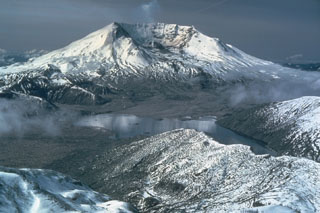Report on St. Helens (United States) — November 1984
Scientific Event Alert Network Bulletin, vol. 9, no. 11 (November 1984)
Managing Editor: Lindsay McClelland.
St. Helens (United States) Seismicity, SO2 emission, and deformation weak
Please cite this report as:
Global Volcanism Program, 1984. Report on St. Helens (United States) (McClelland, L., ed.). Scientific Event Alert Network Bulletin, 9:11. Smithsonian Institution. https://doi.org/10.5479/si.GVP.SEAN198411-321050
St. Helens
United States
46.2°N, 122.18°W; summit elev. 2549 m
All times are local (unless otherwise noted)
Seismicity, SO2 emission, and deformation of the composite lava dome remained at background levels in November. The maximum displacement rate on the N side of the dome was 3 mm/day. SO2 data were successfully collected from four flights in mid to late November. Rates of emission averaged 25 ± 10 t/d. Very few seismic events were recorded in November and early December.
It has proven difficult to discriminate between the seismic signatures produced by different types of surface events, including tephra emissions, snow avalanches, and rockfalls from the dome and crater walls. Field evidence indicates that the seismic signals reported in SEAN 09:10 were not produced by steam-and-ash emissions. Since 24 September, no emissions of tephra from the dome have been observed by field geologists, nor have any tephra layers been found in the snowpack that has been accumulating in the crater through October and November. USGS geologists noted that each of the three most recent large explosions (March 1982, February 1983, and May 1984) were preceded by a period (1.5-5 months) in which no tephra emission events were observed.
Geological Summary. Prior to 1980, Mount St. Helens was a conical volcano sometimes known as the Fujisan of America. During the 1980 eruption the upper 400 m of the summit was removed by slope failure, leaving a 2 x 3.5 km breached crater now partially filled by a lava dome. There have been nine major eruptive periods beginning about 40-50,000 years ago, and it has been the most active volcano in the Cascade Range during the Holocene. Prior to 2,200 years ago, tephra, lava domes, and pyroclastic flows were erupted, forming the older edifice, but few lava flows extended beyond the base of the volcano. The modern edifice consists of basaltic as well as andesitic and dacitic products from summit and flank vents. Eruptions in the 19th century originated from the Goat Rocks area on the N flank, and were witnessed by early settlers.
Information Contacts: D. Swanson, C. Mullins, USGS CVO, Vancouver, WA; C. Jonientz-Trisler, University of Washington.

